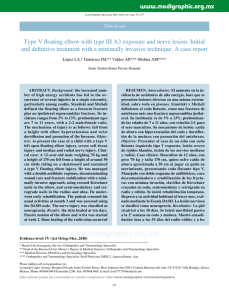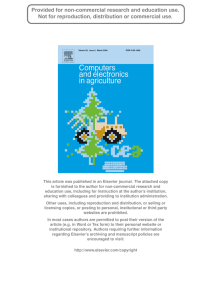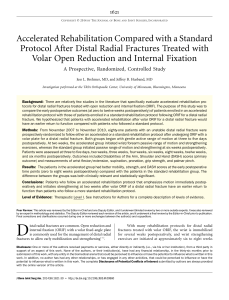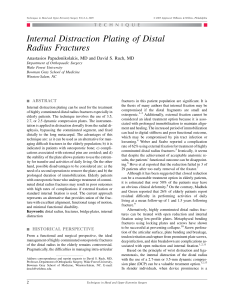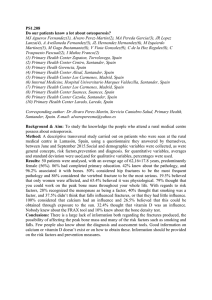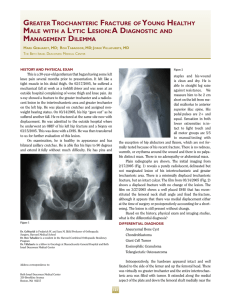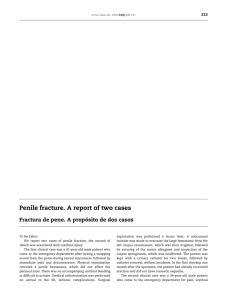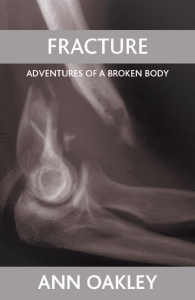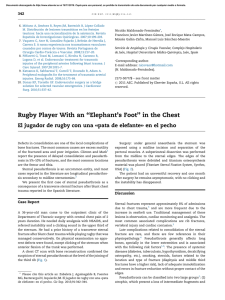Traction table versus manual traction in the intramedullary nailing of unstable intertrochanteric fractures: A prospective randomized trial
Anuncio
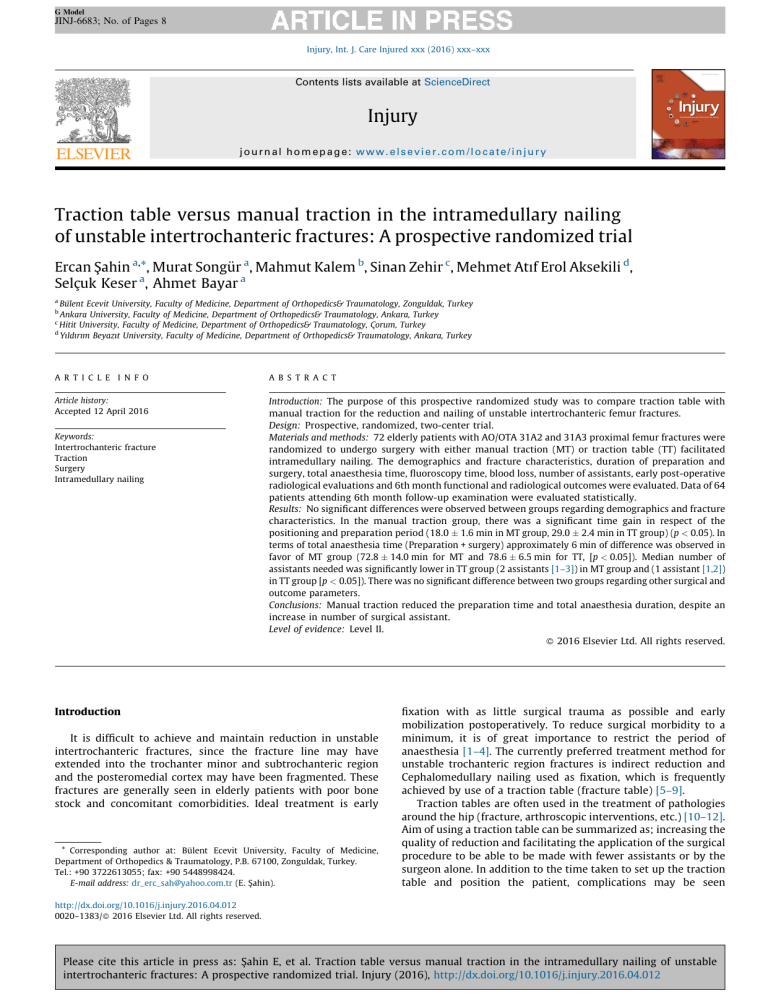
G Model JINJ-6683; No. of Pages 8 Injury, Int. J. Care Injured xxx (2016) xxx–xxx Contents lists available at ScienceDirect Injury journal homepage: www.elsevier.com/locate/injury Traction table versus manual traction in the intramedullary nailing of unstable intertrochanteric fractures: A prospective randomized trial Ercan Şahin a,*, Murat Songür a, Mahmut Kalem b, Sinan Zehir c, Mehmet Atıf Erol Aksekili d, Selçuk Keser a, Ahmet Bayar a a Bülent Ecevit University, Faculty of Medicine, Department of Orthopedics& Traumatology, Zonguldak, Turkey Ankara University, Faculty of Medicine, Department of Orthopedics& Traumatology, Ankara, Turkey Hitit University, Faculty of Medicine, Department of Orthopedics& Traumatology, Çorum, Turkey d Yıldırım Beyazıt University, Faculty of Medicine, Department of Orthopedics& Traumatology, Ankara, Turkey b c A R T I C L E I N F O A B S T R A C T Article history: Accepted 12 April 2016 Introduction: The purpose of this prospective randomized study was to compare traction table with manual traction for the reduction and nailing of unstable intertrochanteric femur fractures. Design: Prospective, randomized, two-center trial. Materials and methods: 72 elderly patients with AO/OTA 31A2 and 31A3 proximal femur fractures were randomized to undergo surgery with either manual traction (MT) or traction table (TT) facilitated intramedullary nailing. The demographics and fracture characteristics, duration of preparation and surgery, total anaesthesia time, fluoroscopy time, blood loss, number of assistants, early post-operative radiological evaluations and 6th month functional and radiological outcomes were evaluated. Data of 64 patients attending 6th month follow-up examination were evaluated statistically. Results: No significant differences were observed between groups regarding demographics and fracture characteristics. In the manual traction group, there was a significant time gain in respect of the positioning and preparation period (18.0 1.6 min in MT group, 29.0 2.4 min in TT group) (p < 0.05). In terms of total anaesthesia time (Preparation + surgery) approximately 6 min of difference was observed in favor of MT group (72.8 14.0 min for MT and 78.6 6.5 min for TT, [p < 0.05]). Median number of assistants needed was significantly lower in TT group (2 assistants [1–3]) in MT group and (1 assistant [1,2]) in TT group [p < 0.05]). There was no significant difference between two groups regarding other surgical and outcome parameters. Conclusions: Manual traction reduced the preparation time and total anaesthesia duration, despite an increase in number of surgical assistant. Level of evidence: Level II. ß 2016 Elsevier Ltd. All rights reserved. Keywords: Intertrochanteric fracture Traction Surgery Intramedullary nailing Introduction It is difficult to achieve and maintain reduction in unstable intertrochanteric fractures, since the fracture line may have extended into the trochanter minor and subtrochanteric region and the posteromedial cortex may have been fragmented. These fractures are generally seen in elderly patients with poor bone stock and concomitant comorbidities. Ideal treatment is early * Corresponding author at: Bülent Ecevit University, Faculty of Medicine, Department of Orthopedics & Traumatology, P.B. 67100, Zonguldak, Turkey. Tel.: +90 3722613055; fax: +90 5448998424. E-mail address: [email protected] (E. Şahin). fixation with as little surgical trauma as possible and early mobilization postoperatively. To reduce surgical morbidity to a minimum, it is of great importance to restrict the period of anaesthesia [1–4]. The currently preferred treatment method for unstable trochanteric region fractures is indirect reduction and Cephalomedullary nailing used as fixation, which is frequently achieved by use of a traction table (fracture table) [5–9]. Traction tables are often used in the treatment of pathologies around the hip (fracture, arthroscopic interventions, etc.) [10–12]. Aim of using a traction table can be summarized as; increasing the quality of reduction and facilitating the application of the surgical procedure to be able to be made with fewer assistants or by the surgeon alone. In addition to the time taken to set up the traction table and position the patient, complications may be seen http://dx.doi.org/10.1016/j.injury.2016.04.012 0020–1383/ß 2016 Elsevier Ltd. All rights reserved. Please cite this article in press as: Şahin E, et al. Traction table versus manual traction in the intramedullary nailing of unstable intertrochanteric fractures: A prospective randomized trial. Injury (2016), http://dx.doi.org/10.1016/j.injury.2016.04.012 G Model JINJ-6683; No. of Pages 8 E. Şahin et al. / Injury, Int. J. Care Injured xxx (2016) xxx–xxx 2 associated with the traction table use, such as neurological injuries (pudendal nerve palsy, sciatic nerve palsy, common peroneal nerve palsy, erectile dysfunction), soft tissue contusions, pressure ulcers, compartment syndrome, crush syndrome and vascular injuries (by-pass graft occlusion, inferior epigastric artery avulsion) [13–18]. Although these complications have been reported quite rare in literature, the exact incidence is not known. Alternatively to avoid these potential problems of traction table, traction can be applied manually on supine position on a normal radiolucent table by help of a surgical assistant for the reduction of fragments and facilitating the intramedullary fixation. The aim of this prospective randomized study was to compare traction table facilitated intramedullary nailing with manual traction facilitated intramedullary nailing of unstable intertrochanteric femur fractures. Materials and methods This study was carried out by approval and supervision of Local Ethical Committee and a total of 72 patients were enrolled in the study from one university hospital and one research and training hospital. Inclusion criteria were defined as AO classification type 31A2 and 31A3 (unstable) proximal femur fractures of elderly patients (age over 60) to undergo closed reduction and internal fixation with intramedullary nail between January 2014 and November 2014. Exclusion criteria were defined as; debilitated patients without walking ability and capacity, additional fractures or pathological fractures. Informed consent was obtained from the patients or from a first degree relative in cases with dementia. The patients were randomized with the permutation block randomization method for 36 patients to undergo surgery with manual traction (MT) and 36 patients to undergo surgery with a traction table (TT). The demographics and fracture characteristics including; gender, age, side, mechanism of injury, ASA (American Society of Anesthesiologists) score, AO fracture type and pre-fracture ambulation scores according to Palmer and Parker [19] were recorded. Surgery preparation Manual Traction: The patients in the manual traction group were placed in a supine position under anaesthesia on the radiolucent table and the fluoroscope was positioned on the opposite side to be able to comfortably show the fracture area. After routine supine positioning, the hip was elevated 308 by placing a folded compress under the sacrum of the same side and leaving the lower extremities free. Then the routine skin preparation and draping were performed. The fracture reduction and preservation of the reduction was achieved with longitudinal traction and manipulation with the aid of an assistant. The status and quality of the fracture reduction were checked with the C-arm fluoroscope in the anterior-posterior and lateral planes. To have a clear lateral image, c-arm was passed from opposite side under operation table and while passing to operation field, extra sterile towels were used to avoid contamination. Since operated side was elevated approximately 308 with a folded compress under sacrum, superposition of uninvolved hip and handle of aiming device could be avoided (Fig. 1a and c). Traction Table: Anaesthesia was administered to the patient on a gurney before transferring to the traction table. The patient was positioned on the fracture table with perineal lateralization post on the opposite side of the fracture site to prevent excessive distraction of the joint. Both lower extremities were fixed to the traction table with the foot apparatus. The contralateral extremity was brought into abduction to allow the C-arm fluoroscopy device to be positioned between legs for optimal AP and lateral view. The fracture fragments were reduced with manipulation under fluoroscopy control and the traction table was fixed into an appropriate position by locking the connections. Occasionally, extra manipulation is required to control position of fracture Fig. 1. C-Arm setup for (a) anteroposterior and (c) lateral view for intramedullary nailing by manual traction applied by a surgical assistant. (b) Antero-posterior and (d) lateral fluoroscopy images showing 1218 of neck-shaft angle. Therefore, quality of reduction was accepted as ‘‘good’’ in this case. Please cite this article in press as: Şahin E, et al. Traction table versus manual traction in the intramedullary nailing of unstable intertrochanteric fractures: A prospective randomized trial. Injury (2016), http://dx.doi.org/10.1016/j.injury.2016.04.012 G Model JINJ-6683; No. of Pages 8 E. Şahin et al. / Injury, Int. J. Care Injured xxx (2016) xxx–xxx 3 Fig. 2. (a) C-Arm setup and antero-posterior and (b,c) lateral images of intramedullary nailing facilitated by traction table. Note that abduction of contralateral hip is necessary for introduction of C-arm between the legs. Neck-shaft angle was measured as 1348 with no shortening. Quality of reduction is accepted as ‘‘anatomic’’. fragments. In such circumstances, an extra assistant was needed to keep the fracture reduced. Then, similarly routine skin preparation and draping were performed. (Fig. 2a) 15 and 25 mm. During insertion and after placement of the implants, two plane fluoroscopy controls were made at each step to ensure fracture reduction and proper implant positioning (Figs. 1b and d and Fig. 2b and 2c). Surgical intervention Data collection All operations were performed at two different centers by two surgeons with at least 5 years of experience on hip and trauma surgery. 18 20 cm. short InterTAN (Smith & Nephew, TN, USA) nails with single distal locking were used for fixation in all patients. Fractures necessitating long nails were not included in the study. Spinal or general anaesthesia was applied. Routine prophylactic antibiotics and pharmacological deep vein thrombosis prophylaxis were administered. Operation team included the operating surgeon and assistant (or assistants). The number of assistants participating in surgery was determined according to need (maintenance of reduction and positioning). Occasionally, especially in obese and large habitus cases or delayed fractures extra assistant was required in both MT and TT cases. Number of assistants participating in the surgery was also recorded. The nailing procedure was applied according to standard surgical protocols. After fracture reduction and reaming of the trochanteric entrance, the nail was placed without any diaphyseal reaming procedure and then two screws (lag and compression screws) were placed in the femoral neck. Intertrochanteric compression was applied and a locking screw was placed from the distal. During the surgery, care was taken to keep neck-shaft angle around 1308 and the Tip-Apex-Distance between Duration of preparation (starting from completion of anaesthesia to incision, including positioning and draping), duration of surgery (incision to wound closure and dressing), fluoroscopy time (minutes for each patient including reduction before preparation in TT group), estimated blood loss (from sponges, aspiration tubes and drains), and number of assistants were recorded. Total anaesthesia time (period between completions of anaesthesia to transfer to recovery room) was also calculated by sum of durations of preparation and surgery for each patient. On post-operative day one, anteroposterior and lateral radiographs were taken and evaluated by a radiologist for reduction and fixation quality. Reduction quality was evaluated according to criteria defined in the study by Schipper et al. The reduction was defined as anatomic (cortical continuity, symmetrical neck shaft angle, no shortening, good (5 108 varus/ valgus) or poor (>108 varus/valgus) [20]. Fixation quality was evaluated according to the position of the neck screw within the femoral head according to the Cleveland and Bosworth quadrants [21]. Postoperatively, the patients were encouraged to be mobilized as soon as possible with a walking frame with partial weight-bearing allowed for 6 weeks. At the end of six weeks, full weight-bearing was permitted. 6th month follow-up examination included physical Please cite this article in press as: Şahin E, et al. Traction table versus manual traction in the intramedullary nailing of unstable intertrochanteric fractures: A prospective randomized trial. Injury (2016), http://dx.doi.org/10.1016/j.injury.2016.04.012 G Model JINJ-6683; No. of Pages 8 E. Şahin et al. / Injury, Int. J. Care Injured xxx (2016) xxx–xxx 4 examination, functional outcome interviews and radiographic evaluations for evaluation of union. Malunion was accepted as >108 of varus or valgus angulation and >10 mm shortening [22]. For functional assessment, ambulation scores according to Palmer and Parker [19] and Harris Hip Scores were calculated [23]. Postoperative complications seen in the follow-up period were also recorded. Statistical analysis Data of patients completing 6th month follow-up examination were included for statistical evaluation. Statistical analysis of the study data was performed with SPSS 19.0 software. Continuous variables were stated as mean, standard deviation, median, minimum and maximum values and categorical variables as frequency and percentage. Conformity to normal distribution of continuous variables was tested with the Shapiro Wilk test and in the comparison of two independent groups; the Mann Whitney U-test was used. In the comparison between groups of categorical variables, the Pearson Chi-Square test, Yates Chi-Square test and Fisher’s Exact Chi-Square test were used. In all the statistical analyzes, p < 0.05 was accepted as statistical significance. Fig. 3. Graph showing the difference between the duration of preparation. Results One patient from MT group was lost during surgery and seven cases (five from MT group and two from TT group) did not attend the recommended 6th month follow-up examination. Therefore, the 6th month evaluation was completed with 64 patients, constituting the study group. The demographics and fracture characteristics including; sex, age, side, mechanism of injury, ASA score, AO fracture type and pre-fracture ambulation scores of both groups were detailed in Table 1. No significant difference was observed between groups regarding demographics and fracture characteristics. In the manual traction group, there was a significant time gain in respect of the positioning and preparation period from the end of anaesthesia to the start of the surgery. Mean duration of preparation was calculated as 18.0 1.6 min in MT group, whereas 29.0 2.4 in TT group. In MT group, the surgery was seen to have started approximately 11 min earlier (p < 0.05) (Fig. 3). Regarding surgery time, despite a delay of approximately 5 min in the manual traction group, no statistically significant difference was observed. In terms of total anaesthesia time (Preparation + surgery) approximately 6 min of difference was observed in favor of MT group (72.8 14.0 min for MT and 78.6 6.5 min for TT, [p < 0.05]) (Fig. 4). The fluoroscopy times of both groups were similar (Table 2). When fluoroscopy time was evaluated according to the Table 1 Patient demographics and fracture characteristics. Gender (male) Age (yrs) Side (right) Mechanism of injury Falling at home Motor vehicle accident Work-related ASA score AO fracture type 31A2 31A3 Pre-fracture ambulation score[19] Manual traction (n = 30) Traction table (n = 34) 11 (36.7%) 76.5 10.2 17 (56.7%) 18 (52.9%) 74.8 10.5 21 (61.8%) 23 (76.7%) 3 (10%) 4 (13.3%) 2.5 1.0 23 (67.6%) 9 (26.5%) 2 (5.9%) 2.4 1.2 9 (30%) 21 (70%) 7.0 1.2 16 (47.1%) 18 (52.9%) 7.2 1.3 Fig. 4. Graph showing the difference between total anaesthesia time. AO fracture type, fluoroscopy time tend to be longer in 31A3 multifragmented per-trochanteric fractures (3.74 0.9 min) compared with 31A2 intertrochanteric fractures (3.2 0.5 min). The difference observed between 31A2 and 31A3 fractures was not statistically Please cite this article in press as: Şahin E, et al. Traction table versus manual traction in the intramedullary nailing of unstable intertrochanteric fractures: A prospective randomized trial. Injury (2016), http://dx.doi.org/10.1016/j.injury.2016.04.012 G Model JINJ-6683; No. of Pages 8 E. Şahin et al. / Injury, Int. J. Care Injured xxx (2016) xxx–xxx 5 Table 2 Details of surgical data. Manual traction (n = 30) Operative time (min) Preparation (anaesthesia-incision) Surgery (incision-wound closure) Total anaesthesia time (min) (anaesthesia-wound closure) Fluoroscopy time (min) Blood loss (ml) Number of assistants Traction table (n = 34) P-value 18.0 1.6 29.0 2.4 P < 0.05 55.1 13.4 72.8 14.0 49.8 4.9 78.6 6.5 P = 0.426 P < 0.05 3.6 1.0 202.3 23.7 2 (1 3) 3.4 0.5 195.2 11.3 1 (1 2) P = 0.918 P = 0.358 P < 0.05 significant. Also no significant difference can be demonstrated according to method of traction. The amount of blood loss was similar in both groups. In the comparison of the number of assistants participating in the surgery, the mean number of assistants needed in the traction table group was seen to be lower. Median number of assistants were two assistants (1 3) in MT group and 1 assistant (1 2) in TT group (p < 0.05) (Fig. 5). (Table 2) In radiological evaluation of the reduction quality in the frontal and sagittal plane from the radiographs taken on post-operative day one, in the manual traction group, anatomic reduction was achieved in 18 (60%) patients, good reduction in 10 (33.3%) and poor reduction in two patients (6.6%). In the traction table group, reductions were anatomic in 25 (73.5%), good in eight (23.5%) and poor in one (2.9%) patient. The differences between groups were statistically not significant. The power analysis of chi-square test of data of reduction quality revealed a power of 78% for sample size of 64 for 0.3 effect size. Fixation quality was evaluated according to the position of the tip of the head screws within femoral head according to Cleveland and Bosworth on both sagittal and coronal planes. Central-central and inferior-central placement of screws at both planes was accepted as optimal fixation. All remaining positioning of screws were accepted as suboptimal fixation, from which superior posterior was the worst one. Optimal positioning of screws was similar at both method of traction. Central-central and inferior-central placement was achieved in 19 cases (63.3%) from the MT group and in 21 cases (61.8%) from traction table group. The rates of screw misplacement, which is accepted as suboptimal fixation, were also similar between both groups. (Table 3) In a total of seven patients out of 72 cases, comprising four patients from the manual traction group and three from the traction table group, closed reduction could not be achieved and reduction was made by partially opening the fracture line. Details of data regarding outcome were detailed in Table 4. None of the patients in TT group experienced traction table related complications. The postoperative length of hospital stay was similar in both groups. In the early postoperative period, superficial infection developed in a total of three patients; two from the manual traction group and one from the traction table group. All these patients were successfully treated with wound care and antibiotics. None of the patients developed deep infection necessitating revision with implant removal. At 6th month visit, functional status scores consisting of ambulation scores and Harris Hips scores were also similar at both groups. Although the ambulation score of all the patients reduced 1.0 1.2 points compared with the preoperative status, no statistically significant difference was determined between the groups in respect of ambulation score and HHS. Radiological malunion was determined in four patients from the manual traction group and one patient from the traction table group. Since none of these malunion cases were symptomatic, no additional intervention was attempted. (Table 4) Fig. 5. Graph showing the difference between numbers of assistants. Discussion Although traction table provides safe and appropriate patient positioning, it can also cause loss of time and complications. Decreasing anaesthetic exposure and operative time is an important step in surgical treatment of high risk elderly patients. When the anaesthesia period of elderly patients with additional comorbidities is prolonged, the complications affecting morbidity and mortality can develop, such as pulmonary complications, deep vein thrombosis and infection [24,25]. Cephalomedullary femoral nails can be applied using a traction table or with manual reduction and traction without using a traction table. While no studies can be found comparing the use of a traction table and manual traction in the application of cephalomedullary nailing in patients with unstable intertrochanteric fractures, there are studies comparing these two traction methods in intramedullary nailing of femoral diaphyseal fractures. In a study by Karpos et al., the effects of manual traction and Please cite this article in press as: Şahin E, et al. Traction table versus manual traction in the intramedullary nailing of unstable intertrochanteric fractures: A prospective randomized trial. Injury (2016), http://dx.doi.org/10.1016/j.injury.2016.04.012 G Model JINJ-6683; No. of Pages 8 E. Şahin et al. / Injury, Int. J. Care Injured xxx (2016) xxx–xxx 6 Table 3 Details of early post-operative radiological evaluations for reduction and fixation quality. Quality of reduction (according to Schipper et al.[20]) Anatomic Good Poor Quality of fixation (according to Cleveland and Bosworth quadrants[21]) Superior-anterior Superior-central Superior-posterior Central-anterior Central-central Central-posterior Inferior-anterior Inferior-central Inferior-posterior Manual traction (n = 30) Traction table (n = 34) 18 (60%) 10 (33.3%) 2 (6.7%) 25 (73.5%) 8 (23.5%) 1 (2.9%) 0 2 1 2 16 3 2 3 1 1 2 1 2 19 3 1 2 3 Table 4 Functional and radiological outcome data of post-operative 6th month follow-up evaluation. Postoperative hospital stay (days) Harris Hip Score (6th month) Ambulation score (6th month) Superficial wound infection Radiological malunion (6th month) Manual traction (n = 30) Traction table (n = 34) 8.8 1.5 69.6 6.7 5.8 1.0 2 (6.6%) 4 (13.3%) 8.3 1.0 71.7 8.4 6.2 1.2 1 (2.9%) 1 (2.9%) traction table were examined on operating time in cephalomedullary nailing in femoral diaphyseal fractures. It was reported that the anaesthesia period was approximately 33 min shorter with manual traction [26]. Similarly, Stephen et al. [12] made a prospective, randomized comparison of the two methods of traction in femoral nailing revealing a shorter total operating time in favor of manual traction. Wolinsky et al. [27] also reported that the use of a traction table caused a loss of time and manual traction was a much more rapid method. In the current study, the preparation time for surgery (positioning from anaesthesia application to starting the incision, cleaning, draping) of the patients in the manual traction group was significantly shorter than that of the traction table group. Surgery was started in the manual traction group with a time-saving of approximately 11 min. Intra-operatively some loss of time is expected for achievement and maintenance of reduction in manual traction group, since reduction was achieved and maintained before incision in TT group. This theory did not translate to surgical data. Although there was approximately 5 min of loss of time in the mean surgery time in the manual traction group, the difference between groups did not reach statistical significance (p = 0.426). When total anaesthesia time was analyzed, which is the sum of preparation time and duration of surgery, approximately 6 min difference was observed in favor of MT group (p < 0.05) (Table 2). The difference observed in current study was less than previously reported studies regarding femoral intramedullary nailing. The reason for such difference can be contributed to the factors related with difference in surgical technique (femoral diaphyseal nailing, distal locking, etc.). Despite a significant difference of total anaesthesia time between TT and MT groups, this difference (6 min) did not translate to outcome and intra-operative anaesthesia related complications. But with large-scale comparative and prospective outcome studies, such a difference might affect outcome. There is a scarcity in the literature regarding the amount of fluoroscopy utilized during fixation of intertrochanteric fractures. Some studies reported the amount of fluoroscopy as minutes, some studies reported as ‘‘shoots’’. This difference complicates the interpretation and comparison between the results of previous studies. Zhang et al. reported mean fluoroscopy duration of 3.6 0.18 min in 57 patients operated with traction table. Similarly, Wu et al. reported the mean fluoroscopy time as 2.9 0.16 using traction table. Wang et al. reported the fluoroscopy time in 59 patients treated with InterTAN nail using traction table as 16.3 4.4 shoots [28–30]. In current study, duration of fluoroscopy in TT group was comparable with previous studies. Although shorter fluoroscopy was expected due to stable positioning and straightforward imaging with traction table, no statistically significant difference was observed between the two groups in respect of fluoroscopy time (3.6 1.0 min in MT group vs 3.4 0.5 min in TT group [p = 0.918]). Despite similar fluoroscopy time was recorded in both groups, amount of radiation exposure might be higher in MT group since operation team is more approximated to patient and C-arm device. To determine this, potential difference studies utilizing X-ray dosimetry devices is needed. We also analyzed the fluoroscopy time according to fracture type according to AO classification. Theoretically, it is expected to use more fluoroscopy in more comminuted fractures. Although there was a slight increase in fluoroscopy time in multifragmented AO type 31A3 per-trochanteric fractures, compared with less comminuted AO type 31A2 intertrochanteric fractures (3.74 0.9 min vs 3.2 0.5 min, respectively), the difference did not reach statistical significance (Table 2). Blood loss is an important determinant of morbidity and mortality in surgical treatment of hip fractures in elderly [31]. Estimated blood loss during intramedullary nailing of intertrochanteric fractures using traction table, reported in literature ranged between 70.1 27.7 and 235 124.6 ml [28–30]. In our study, mean blood loss was 202.3 23.7 ml in manual traction group, whereas 195.2 11.3 ml in traction table group. The results were concordant with previous literature and no significant difference regarding blood loss was observed according to the method of traction utilized. In our study, despite positive effect of manual traction method in terms of reduction of surgical site preparation and anaesthesia time, this method resulted with significant increase in number of surgical assistants (Table 2). Number of surgical assistant may be an important determinant of resource utilization and cost, especially in developed countries. In a recent multicenter study about cost analysis of hip fracture cases from Netherlands, surgeon cost was reported to be between 109 and 143 s per hour [32]. Additionally, increase in number of sterile personnel in operation theatre also may increase the infection rate [33]. But, in terms of reduction of anaesthesia period and patients benefit, the circumstances of increased number of surgical assistance can be justified. Traction table is a successful method of achieving and maintenance of reduction. When combined with stable, load sharing and durable fixation with intramedullary devices, successful results can be achieved. When appropriate surgical technique is utilized, good-anatomic reduction can be achieved in 83 100% of cases [7,8,34–36]. In current study, good-anatomic reduction could be obtained and maintained in the vast majority (total 93.3% MT group, total 97.1% TT group) of cases. Only two cases in manual traction group (6.7%) and one case in traction table group (2.9%) revealed poor reduction radiologically. Also anatomical reduction was achieved in 60% of cases in MT group and 73.5% of cases in TT group. We performed a power analysis revealing a Please cite this article in press as: Şahin E, et al. Traction table versus manual traction in the intramedullary nailing of unstable intertrochanteric fractures: A prospective randomized trial. Injury (2016), http://dx.doi.org/10.1016/j.injury.2016.04.012 G Model JINJ-6683; No. of Pages 8 E. Şahin et al. / Injury, Int. J. Care Injured xxx (2016) xxx–xxx rate of 78% for the study sample size for 0.3 effect size. Although difference in number of poor reduction cases is two-fold, the statistical difference between two groups did not reach significance. To increase power rate of this analysis to 98.7%, sample size was calculated to be 320. Further studies should take this point into consideration for determination of sample size. With largescale studies focusing on reduction quality, this significance can be demonstrated. There are some methods evaluating the fixation quality of hip fractures, including Tip-Apex-Distance and Cleveland-Bosworth quadrants. Since there is a close resemblance of orientation of neck screws in InterTAN nailing with DHS screw, we used Cleveland Bosworth quadrants method for fixation quality. According to this method, central-central and inferior-central positioning is accepted as optimal fixation. Turgut et al. [37] achieved optimal fixation in 53.5% of cases using PFN-A as the fixation device in a study reporting intramedullary nailing in lateral decubitus position with manual traction. In our study at 63.3% of cases in MT group and 61.8% of cases in TT group, optimal fixation was achieved. We also did not find any relation with suboptimal fixation and fixation failure (Table 3). Hospitalization period is commonly influenced by comorbidities, cognitive and functional capabilities of the patient. Mean hospital stay of intertrochanteric fractures treated with intramedullary nail fixation ranged between 21.7 to 8.03 days in previous studies [19,28,38]. In our study mean hospitalization durations were 8.8 1.5 and 8.3 1.0 days for MT and TT groups, respectively. No significant difference was observed according to the method of traction. At 6th month follow-up, ambulation scores according to Palmer and Parker were similar in MT and TT groups as 5.8 1.0 and 6.2 1.2, respectively. Harris Hip Scores were also similar as 69.6 6.7 in MT group and 71.7 8.4 in TT group. Overall, complication rates were also similar between two groups (Table 4). We also did not encounter any complication related with traction method used. It was previously concluded in a review by Butler et al. as; functional recovery in intertrochanteric fractures in elderly was not related with fracture type and implant used, rather influenced by age, pre-fracture functional and cognitive status [39]. In this study, functional results observed at both groups were comparable with previously reported studies [28,38,40]. In this study, we observed only 11.1% loss of follow up rate, which increased the quality of the study. There are some limitations in our study. Functional evaluations of some cases with impaired cognitive status were made by interviewing with a relative or a caregiver involved with the principal care of the patient. Conclusions Manual traction and traction table facilitated intramedullary fixation of intertrochanteric fractures revealed similar results. Intramedullary nailing for unstable intertrochanteric femoral fractures could be performed by both methods effectively and safely. However, manual traction reduced the preparation time and total anaesthesia duration, despite an increase in number of surgical assistant. Conflicts of interest None declared. Acknowledgments Authors wish to thank Dr. Mustafa Cagatay BUYUKUYSAL for his contribution on the statistical analyses of the study. 7 References [1] Nunes JC, Braz JR, Oliveira TS, de Carvalho LR, Castiglia YM, Braz LG. Intraoperative and anesthesia-related cardiac arrest and its mortality in older patients: a 15-year survey in a tertiary teaching hospital. PLoS One 2014;9(8):e104041. [2] Brown CH, Azman AS, Gottschalk A, Mears SC, Sieber FE. Sedation depth during spinal anesthesia and survival in elderly patients undergoing hip fracture repair. Anesth Analg 2014;118(5):977–80. [3] Rashid RH, Shah AA, Shakoor A, Noordin S. Hip fracture surgery: does type of anesthesia matter? Biomed Res Int 2013;252–356. [4] Drexler B, Grasshoff C. Is deep anesthesia dangerous? Anaesthesist 2012;61(8):678–81. 684-5. [5] Lindskog DM, Baumgaertner MR. Unstable intertrochanteric hip fractures in the elderly. J Am Acad Orthop Surg 2004;12:179–90. [6] Roberts KC, Brox WT, Jevsevar DS, Sevarino K. Management of hip fractures in elderly. J Am Acad Orthop Surg 2015;23:131–7. [7] Haidukewych GJ. Intertrochanteric fractures. Ten tips to improve results. J Bone Joint Surg Am 2009;91:712–9. [8] Sadowski C, Lübbeke A, Saudan M, Riand N, Stern R, Hoffmeyer P. Treatment of reverse oblique and transverse intertrochanteric fractures with use of an intramedullary nail or a 958 screw. J Bone Joint Surg 2002;84-A(3):372–81. [9] Swart E, Makhni EC, Macaulay W, Rosenwasser MP, Bozic KJ. Cost-effectiveness analysis of fixation options for intertrochanteric hip fractures. J Bone Joint Surg Am 2014;96(19):1612–20. [10] Rankin JO. A new fracture table to be used in conjunction with the fluoroscope. J Bone Joint Surg Am 1927;9:447–9. [11] Byrd JW. Hip arthroscopy. J Am Acad Orthop Surg 2006;14(7):433–44. [12] Stephen DJ, Kreder HJ, Schemitsch EH, Conlan LB, Wild L, McKee MD. Femoral intramedullary nailing: comparison of fracture-table and manual traction. A prospective, randomized study. J Bone Joint Surg Am 2002;84(9):1514–21. [13] Flierl MA, Stahel PF, Hak DJ, Morgan SJ, Smith WR. Traction table–related complications in orthopaedic surgery. J Am Acad Orthop Surg 2010;18: 668–675. [14] Chan PT, Schondorf R, Brock GB. Erectile dysfunction induced by orthopedic trauma managed with a fracture table: a case report and review of the literature. J Trauma Injury Infect Crit Care 1999;47:183–5. [15] Aboulker P, Benassayag E. Contusion of the perineum by pelvic support on an orthopedic table (2 cases). Ann Urol (Paris) 1971;5(September (3)):169–70. [16] Hofmann A, Jones RE, Schoenvogel R. Pudendal-nerve neuropraxia as a result of traction on the fracture table. A report of four cases. J Bone Joint Surg Am 1982;64(1):136–8. [17] Wiltfong RE, Taylor BC, Steensen RN. Lower extremity bypass graft occlusion after intramedullary fixation of intertrochanteric hip fracture on a fracture table. Orthopedics 2011;34(5):395. [18] Haddad FS, Cobiella CE, Wilson L. Inferior epigastric artery avulsion: a fracture table complication. J Orthop Trauma (Case Rep) 1998;12:587–8. [19] Parker MJ, Palmer CR. A new mobility score for predicting mortality after hip fracture. J Bone Joint Surg (Br). 1993;75-B:797–8. [20] Schipper IB, Steyerberg EW, Castelein RM, van der Heijden FH, den Hoed PT, Kerver AJ, et al. Treatment of unstable trochanteric fractures. Randomized comparison of the gamma nail and the proximal femoral nail. J Bone Joint Surg [Br] 2004;86-B:86–94. [21] Cleveland M, Bosworth DM, Thompson FR, Wilson HJ, Ishizuka T. A ten-year analysis of intertrochanteric fractures of the femur. J Bone Joint Surg Am 1959;41-A:1399–408. [22] Chechik O, Amar E, Khashan M, Pritsch T, Drexler M, Goldstein Y, et al. Favorable radiographic outcomes using the expandable proximal femoral nail in the treatment of hip fractures. A randomized controlled trial. J Orthop 2014;11:103–9. [23] Harris WH. Traumatic arthritis of the hip after dislocation and acetabular fractures: treatment by mold arthroplasty: an end-result study using a new method of result evaluation. J Bone Joint Surg [Am] 1969;51-A:737–55. [24] Jaffer AK, Barsoum WK, Krebs V, Hurbanek JG, Morra N, Brotman DJ. Duration of anesthesia and venous thromboembolism after hip and knee arthroplasty. Mayo Clin Proc 2005;80(6):732–8. [25] Byrne AM, Morris S, McCarthy T, Quinlan W, O’byrne JM. Outcome following deep wound contamination in cemented Arthroplasty. Int Orthop (SICOT) 2007;31:27–31. [26] Karpos PA, McFerran MA, Johnson KD. Intramedullary nailing of acute femoral shaft fractures using manual traction without a fracture table. J Orthop Trauma 1995;9:57–62. [27] Wolinsky PR, McCarty EC, Shyr Y, Johnson KD. Length of operative procedures: reamed femoral intramedullary nailing performed with and without a fracture table. J Orthop Trauma 1998;12:485–95. [28] Zhang S, Zhang K, Jia Y, Yu B, Feng W. InterTan nail versus proximal femoral nail antirotation-Asia in the treatment of unstable trochanteric fractures. Orthopedics 2013;36(3):e288–94. [29] Wu D, Ren G, Peng C, Zheng X, Mao F, Zhang Y. InterTan nail versus Gamma3 nail for intramedullary nailing of unstable trochanteric fractures. Diagn Pathol 2014;9:191. [30] Wang Q, Yang X, He HZ, Dong LJ, Huang DG. Comparative study of interTAN and dynamic hip screw in treatment of femoral intertrochanteric injury and wound. Int J Clin Exp Med 2014;7(12):5578–82. [31] Zhang JQ, Xue FS, Meng FM, Liu GP. Is basal haemoglobin level really a prognostic factor for early death of elderly patients undergoing hip fracture surgery? Injury 2015;46(10):2079–80. Please cite this article in press as: Şahin E, et al. Traction table versus manual traction in the intramedullary nailing of unstable intertrochanteric fractures: A prospective randomized trial. Injury (2016), http://dx.doi.org/10.1016/j.injury.2016.04.012 G Model JINJ-6683; No. of Pages 8 8 E. Şahin et al. / Injury, Int. J. Care Injured xxx (2016) xxx–xxx [32] Burgers PT, Hoogendorn M, Van Woensel EA, Poolman RW, Bhandari M, Patka P, et al. Total medical costs of treating femoral neck fracture patients with hemi- or total hip arthroplasty: a cost analysis of a multicenter prospective study. Osteoporos Int 2016. http://dx.doi.org/10.1007/s00198-016-3484-z. [33] Howard JL, Hanssen AD. Principles of a clean operating room environment. Arthroplasty 2007;22(7 Suppl 3):6–11. [34] Kregor PJ, Obremskey WT, Kreder HJ, Swiontkowski MF. Unstable pertrochanteric femoral fractures. J Orthop Trauma 2014;28:25–8. [35] Pelet S, Arlettaz Y, Chevalley F. Osteosynthesis of per- and subtrochanteric fractures by blade plate versus gamma nail. A randomized prospective study. Swiss Surg 2001;7:126–33. [36] Madsen JE, Naess L, Aune AK, Alho A, Ekeland A, Strømsøe K. Dynamic hip screw with trochanteric stabilizing plate in the treatment of unstable proximal femoral fractures: a comparative study with the Gamma nail and compression hip screw. J Orthop Trauma 1998;12:241–8. [37] Turgut A, Kalenderer Ö, Günaydın B, Önvural B, Karapınar L, Ağuş H. Fixation of intertrochanteric femur fractures using Proximal Femoral Nail Antirotation (PFNA) in the lateral decubitus position without a traction table. Acta Orthop Traumatol Turc 2014;48(5):513–20. [38] Matre K, Vinje T, Havelin L, Trıgen, Gjertsen JE, Furnes O, Espehaug B, et al. Trıgen ıntertan intramedullary nail versus sliding hip screw: a prospective, randomized multicenter study on pain, function, and complications in 684 patients with an intertrochanteric or subtrochanteric fracture and one year of follow-up. J Bone Joint Surg Am 2013;95(3):200–8. [39] Butler M, Forte ML, Joglekar SB, Swiontkowski MF, Kane RL. Evidence summary: systematic review of surgical treatments for geriatric hip fractures. J Bone Joint Surg Am 2011;93(12):1104–15. [40] Okcu G, Ozkayin N, Okta C, Topcu I, Aktuglu K. Which implant is better for treating reverse obliquity fractures of the proximal femur: a standard or long nail? Clin Orthop Relat Res 2013;471(9):2768–75. Please cite this article in press as: Şahin E, et al. Traction table versus manual traction in the intramedullary nailing of unstable intertrochanteric fractures: A prospective randomized trial. Injury (2016), http://dx.doi.org/10.1016/j.injury.2016.04.012
